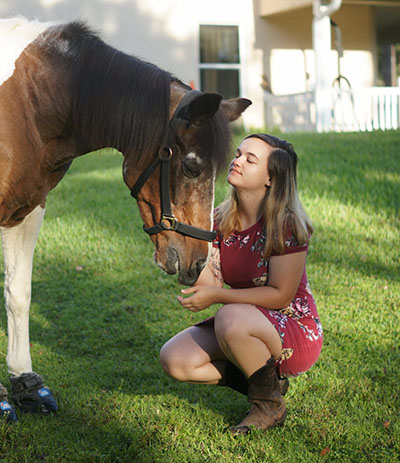The past several months have been difficult for 20-year-old Morgan Hamilton, as she managed the end-of-life care for her geriatric horse, Pippin MacDuff, who had reached a nearly unprecedented 42 years of age.
The Town-Crier featured Hamilton and her horse in the Sept. 14 article “Young Owner Helps Senior Horse Age With Dignity.” Pippin was humanely euthanized shortly after the article was published.
Sensing the end was near, Hamilton took the semester off from studying sign language at the University of North Florida in Jacksonville to spend as much time with Pippin as possible. The horse was boarded at the farm of Loxahatchee Groves resident Darcy Dean Murray.
“I spent every night here for two weeks,” Hamilton said. “I stayed over to see him the next morning. Darcy let me stay here.”
Hamilton chose to share her story of loss to help others who will ultimately have to come to the decision to let their horse go.
“Try to get as much information about getting your horse put down as possible,” Hamilton suggested. “It’s not bad — it makes it easier.”
During her last interview, Hamilton was unsure if she would ever own a horse again, but after having time to process Pippin’s loss, she became more optimistic.
“Once I’m out of college, I would prefer a rescue [again],” she said.
Hamilton removed Pippin’s tail as a keepsake, which is currently being turned into a bracelet by 4EverInMyHeart.com. She also kept the nameplate that adorned his former stall in Murray’s barn.
“I’ve lost too many horses,” Murray said. “It never gets easier.”
There was a moment several months ago when farrier Chris Burrell determined that Pippin was in great pain from laminitis. At that time, they considered euthanasia, and Hamilton shared a moment that she believed was Pippin giving her permission to let go.
“Pippi kept nudging me as I was crying,” Hamilton said. “It was him telling me, ‘That’s OK, you can let me go.’”
Although Pippin received treatment at the time to manage his pain — including medication and a specialized boot — he never fully recovered.
“He would be laying down breathing heavy. He couldn’t cool down,” Hamilton recalled. “He was limping so bad. He would fight me to stay on the concrete.”
Pippin, for his part, would not give up and remained upright in the barn for two consecutive days.
“I think he was afraid that if he lay down, he wouldn’t get back up,” Hamilton explained.
It soon became clear to Hamilton and Murray that the time to let Pippin go was fast approaching.
“If he didn’t get better, I can’t let him sit through this,” Hamilton said. “He was already in so much pain with laminitis.”
Pippin was scheduled for a veterinary checkup, but by Thursday, Sept. 13, his condition had worsened, and the decision to euthanize him was made.
“I slept out in the barn, but didn’t really sleep,” Hamilton recalled.
Pippin was taken to an area in the front corner of Murray’s property where the other horses that are boarded on the farm would not be able to see.
“It was a really nice area,” Hamilton said. “It was shaded. The sun was just right. Pippin was munching on the grass.”
The euthanasia process involves a series of injections that first begins with placing the horse in a coma followed by a second injection that stops the heart.
It was suggested to Hamilton that she not watch the process, but she refused. “I’m not going anywhere,” Hamilton recalled telling Murray and the veterinarian. “I held his head up. All of his weight was in my hands. I was rubbing his face. He was so relaxed. I sat down on the grass and put his head in my lap. I saw his pain leaving his face — then he wasn’t breathing anymore. He was gone so fast. Leaving him and walking away was the hardest part.”
Pippin MacDuff maintained his dignity to the end. The horses on Murray’s farm were silent the next day.








